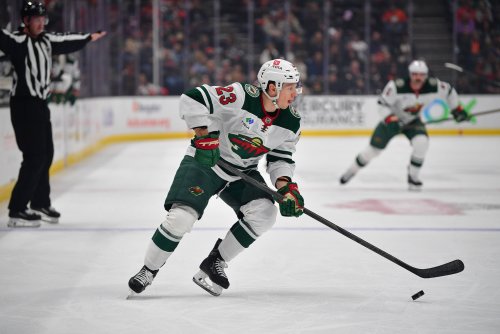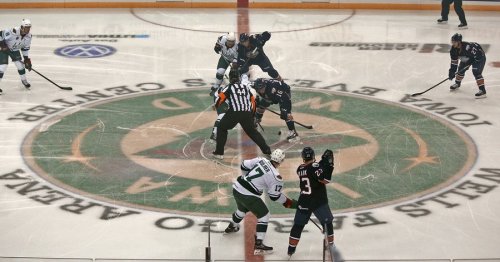
After a look at the Minnesota Wild’s offense yesterday, today we’re going to look at where the team’s defense stands ahead of the 2019-20 season. In terms of overall team defense there haven’t been many other teams over the last few seasons that have taken away the slot from opposing teams like the Wild. With four regular defensemen about to appear in their seventh season or more with the team and a handful of strong two-way forwards to help it’s easy to see how the strength and foundation of the Wild is their defense.
For years the Minnesota Wild’s approach to defense has been focusing on limiting the quality of chances against rather than just the quality of chances against. That sounds like a pretty cliché thing to say about any team, but above are some numbers to prove it. Looking at the last six seasons, Minnesota has finished in the top 10 in terms of Corsi (shots on goal, missed shots, and blocked shots combined) Against per 60 at 5-on-5 twice, with their best finish being in 2013-14 when they yielded the seventh fewest shot attempts against per 60. In that same time they’ve also managed to finish in the bottom 10 in terms of shot suppression at even-strength by finishing 21st in the league in 2016-17 with 55.44 shot attempts against per 60, and in 2017-18 with a 58.32 Corsi Against per 60 to finish 20th.
When transitioning from overall shot attempts against to expected goals against, the Wild corner the market on taking away golden chances from opponents. Minnesota has finished first in the league in expected goals against per 60 at even-strength in four of the last six seasons. The lone two times they didn’t outperform the entire league were in 2013-14 (where 1.78 expected goals against per 60 was second to the New Jersey Devils’ 1.65), and in 2015-16 (when they finished fourth in the league with 1.96). If that doesn’t do it for you, consider the fact that in each of the last six seasons as well the Wild have yielded under 2.00 expected goals against per 60. They’ve provided six of the 33 instances since the start of the 2013-14 campaign where a team finished with under 2.00 expected goals against per 60 at 5-on-5 over an entire season. They are also the only team to have accomplished the feat in each of the six seasons, as Bruce Boudreau’s squad is the only team to do it (and they’ve done it twice) in the last two years.
In regards to these two stats the Wild had a typical season. They finished with a Corsi Against per 60 of 55.41 at 5-on-5 this season to finish 10th in the league and 1.97 expected goals against per 60 was the lowest in the league. The Wild did see a slight increase to their 5-on-5 goals-against total with 156 being 11 more than their total from last season. However, an extra goal against every seven or eight games isn’t that much of a drastic difference than what Minnesota’s blue line has provided over the last few seasons. Overall, it looks as though the defensive system was yet again clicking, but how did each blue liner look?
The Regulars
Let’s take a deeper look at each one.
The Extras
With Bitetto (Winnipeg Jets), Prosser (Philadelphia Flyers), and Murphy (Neftekhimik Nizhnekamsk in the KHL) gone, the only two defensemen still with the organization are Louie Belpedio and Matt Bartkowski. Belpedio is 23 years old and played two of his three career NHL games this past season in a very limited role. He’s one of the better prospects in the organization who will definitely see more NHL time over the next few years and may even see a huge increase in 2019-20 once he signs his next contract. As for Bartkowski it’s hard to imagine he starts (and finishes?) next season anywhere other than with the Iowa Wild.
Looking At The Pairs
Now that we’ve seen what types of seasons Minnesota’s blue liners provided on an individual level in 2018-19, let’s look at what worked in Paul Fenton’s only season as Wild GM.
Listed above are eight of the nine defensemen pairs that played at least 100 even-strength minutes together last season. The ninth pair was Seeler and Prosser, but since Prosser is no longer with the franchise, he probably isn’t going to be getting a lot of ice time with the Wild (genius, I know).
There really is no other option for the top pair besides Suter and Spurgeon. That isn’t because they are the only good blue liners on the team. It’s because of how dominant both players are individually and how well they work together. The pair was one of eight across the entire NHL to play 1,000 minutes or more at 5-on-5 together. Out of those eight pairs, Suter-Spurgeon provided the third-highest Corsi For percentage, the lowest expected goals against per 60 rate, and the second best expected goals for percentage by only 0.02. Both players may not make the flashiest plays or lead the league in scoring as a defenseman, but it really doesn’t matter since they are one of the best duos in the game in terms of tilting the ice while logging some of the hardest minutes in the league.
Another pair that seemed to have some success last season was Pateryn and Brodin. They lack the offensive upside and puck-moving abilities of the top pair, but for their unfavorable deployment this past season the two managed to post impressive shot suppression numbers. Of the 36 defense pairs that played 600 or more 5-on-5 minutes together, Pateryn-Brodin started the second lowest percentage of their shifts in the offensive zone (Andy Greene and Damon Severson started 37.28 percent of their shifts in the offensive zone for New Jersey) and were the only pair to have an offensive zone face-off percentage under 40. Although they were set up to struggle, the tandem of Pateryn and Brodin provided the lowest expected goals against per 60 rate by 0.13 to Dustin Byfuglien’s and Ben Chariot’s 1.85. They were also one of just 11 of those 36 pairs to post an expected goals for percentage of 53 or better. If Boudreau and company roll with these two as the second or third pair, it’s all for neutralizing a threatening opposing line with low-event hockey while hoping the other two defensive pairs produce offensively — because this pair is terrible at that part of the game.
That leaves Dumba on a pair to produce in a sheltered role with either Hunt or Seeler. Since Seeler isn’t a prospect and the Wild decided to add Hunt midseason, it feels like the third pair will be Dumba and Hunt to start. Obviously they didn’t play together at all last season, but giving Dumba sheltered minutes should allow him to keep lighting up the scoreboard. He had a little bit of a high shooting percentage last season, but Dumba has shown he knows how to find the back of the net and outside of Spurgeon nobody else on this blue line is capable of producing at the same rate.
The combos of Suter-Spurgeon, Pateryn-Brodin, and Dumba-Hunt seem to check off a lot of boxes when it comes to a good defense. One of the most reliable and steady pairs in the league in Suter-Spurgeon, a pair that won’t produce much but can slow opponents down with low-event hockey while handling tough minutes in Pateryn-Brodin, and a pair with a dynamic offensive threat who could post 15 goals in Dumba-Hunt. This isn’t factoring in the possibility that Belpedio might earn a spot in camp and be on the opening night roster. If the young puck-mover makes the roster, Boudreau could supplement both his bottom pairs with a puck-moving defenseman and a stay-at-home type with Brodin-Dumba and Pateryn-Belpedio. Personally, I’m hoping this is how it pans out for Minnesota because it maximizes the defense’s offensive abilities while placing at least one stay-at-home rearguard that can successfully limit opposing chances regardless of usage on each pair.
The Wild didn’t make the playoffs this year, but it’s really hard to blame that on the defense. With only two forwards that posted 50 points or more and the fact that Dumba finished sixth on the team in goals despite playing under half of the season, it feels like the issue in Minnesota is scoring goals. The Wild need some improvements to make a return to the postseason, but the unit that needs the least tweaking is the defense.
Think you could write a story like this? Hockey Wilderness wants you to develop your voice, find an audience, and we'll pay you to do it. Just fill out this form.









Recommended Comments
There are no comments to display.
Join the conversation
You can post now and register later. If you have an account, sign in now to post with your account.
Note: Your post will require moderator approval before it will be visible.